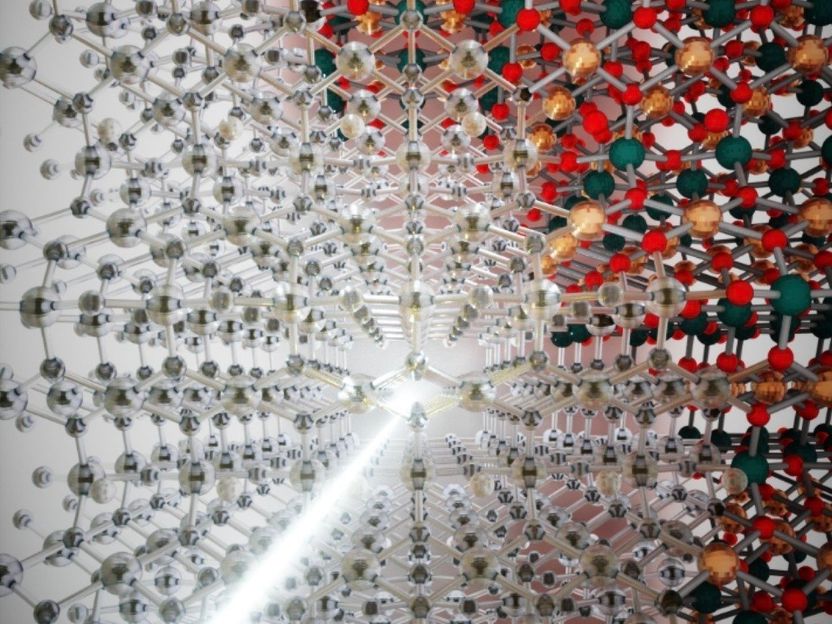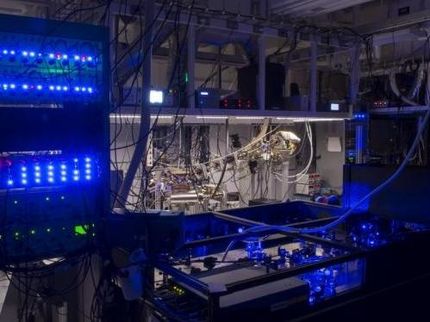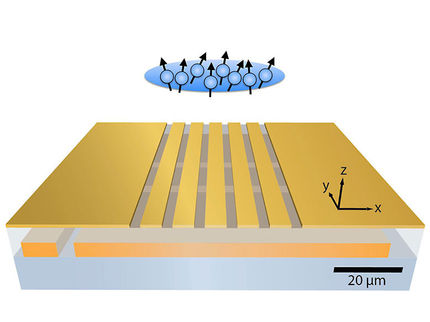Inducing transparency by kicking the atoms
All photo-electronic devices work on the basis that the materials inside them absorb, transmit and reflect light. Understanding the photo properties of a specific material at the atomic level not only helps to decide what material to choose for a given application but also opens up ways to control such properties on demand. In a new collaborative work, researchers from Italy, Germany and the United States show how ‘kicking’ the atoms in a CuGeO3 crystal with an infrared laser pulse can not only make the material transparent but that the transparency can then be controlled on an ultrafast femtosecond scale.

Artistic impression of vibrationally induced transparency in CuGeO3
© University of Trieste / INSRL
This result paves the way for the further application of the atomic kicking scheme to enhance other phenomena such as, for example, superconductivity. The work has now been published in Nature Physics.
The design of complex materials with new functionalities is often a result of the interplay between different components of the matter, such as electrons and crystal vibrations - the so-called phonons. The coupling between these matter components can be of an incoherent or coherent nature. While the former is usually the result of the nuclear fluctuations induced by the temperature, the latter is achieved when the crystal vibrations and the electronic excitations propagate in the material with the same frequency and at constant phase difference.
Here, the researchers use resonant vibrational excitation to coherently control the crystal field surrounding the Cu2+ ions in a CuGeO3 crystal. This material is ideal for two main reasons: the phonons can be kicked selectively via mid-infrared laser pumping and the three characteristic d–d electronic transitions at high energy (around 1.7eV) are isolated from other spectral features that could interfere with the electron-phonon coupling.
In particular, the resonant excitation of IR-active phonon modes, which are non-linearly coupled to Raman active phonon modes, results in a coherent vibrational motion of the apical oxygen that dynamically controls the energy and oscillator strength of the orbital transition between different crystal levels on Cu2+ ions. By controlling the parameter of the phonon pumping schemes it is then possible to achieve a transparency in the energy window of the d-d electronic transitions.
“It is fascinating to see how distinct matter excitations that belong to completely different energy regions can coherently interact and affect the macroscopic properties of a crystal,” says Simone Latini, a post-doc and former Humboldt fellow at the MPSD. “We are currently investigating if a similar phenomenon can be observed elsewhere and we have a hint that it could be present in two-dimensional materials such as WS2.”
“This study shows how far we have gone experimentally in terms of controlling matter with ultrashort light pulses,” says Alexandre Marciniak, the author of this work together with Stefano Marcantoni of the University of Trieste. “It is indeed remarkable how we can unveil the intimate microscopic relationships between excitations in a material and how this understanding can be utilized to fabricate functional devices that can become transparent on demand.”
The project, financially supported mainly by the European Research Council (project INCEPT), was carried out at the Q4Q lab led by Daniele Fausti of the University of Trieste at Elettra Sincrotrone Trieste. The theoretical model was developed in the group of Fabio Benatti at the University of Trieste, in collaboration with researchers in Ángel Rubio’s group at the MPSD and Jeroen van den Brink at the IFW / the Institute for Theoretical Physics in Dresden.
MPSD Theory director Ángel Rubio concludes: “This work opens up new avenues to control and design phenomena in correlated and topological materials.”
Original publication
Most read news
Original publication
A. Marciniak, S. Marcantoni, F. Giusti, F. Glerean, G. Sparapassi, T. F. Nova, A. Cartella, S. Latini, F. Valiera, A. Rubio, J. van den Brink, F. Benatti, D. Fausti; "Vibrational coherent control of localized d–d electronic excitation"; Nature Physics; 2021
Organizations
Other news from the department science

Get the chemical industry in your inbox
By submitting this form you agree that LUMITOS AG will send you the newsletter(s) selected above by email. Your data will not be passed on to third parties. Your data will be stored and processed in accordance with our data protection regulations. LUMITOS may contact you by email for the purpose of advertising or market and opinion surveys. You can revoke your consent at any time without giving reasons to LUMITOS AG, Ernst-Augustin-Str. 2, 12489 Berlin, Germany or by e-mail at revoke@lumitos.com with effect for the future. In addition, each email contains a link to unsubscribe from the corresponding newsletter.




























































